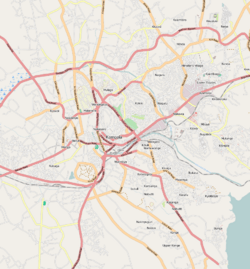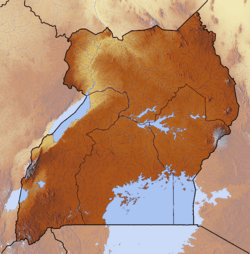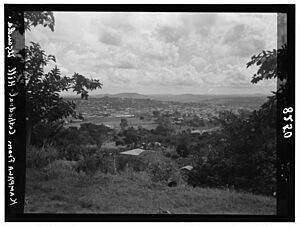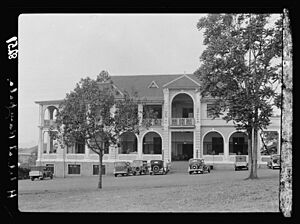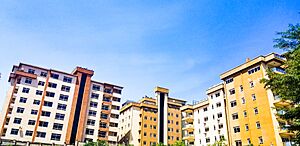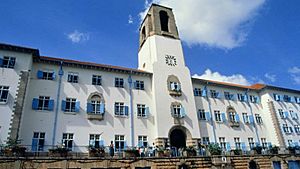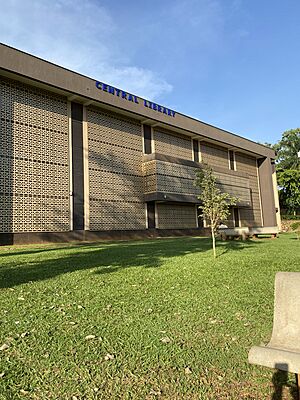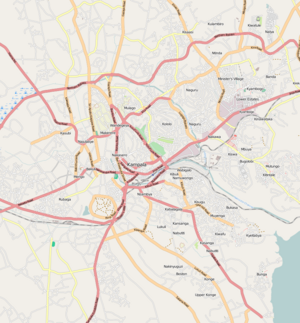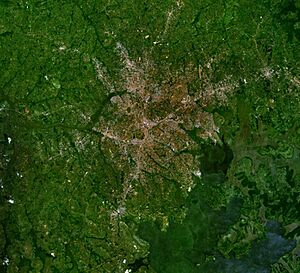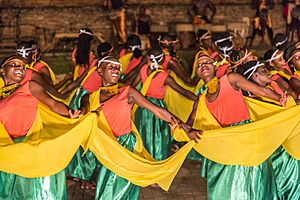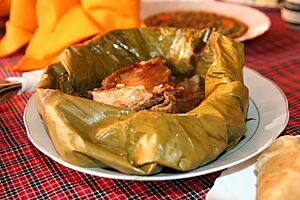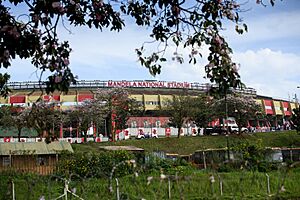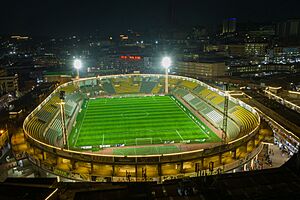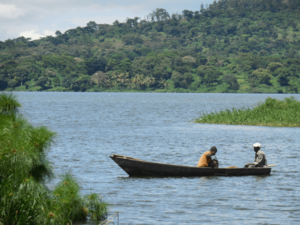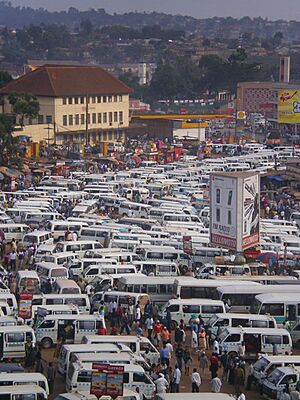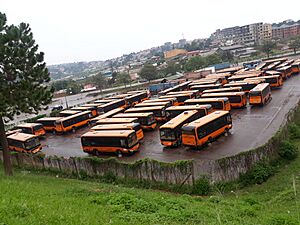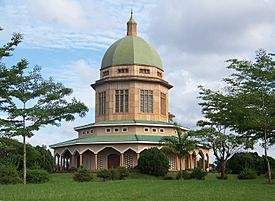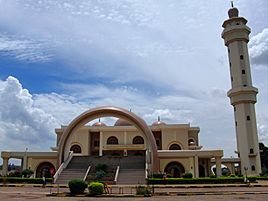Kampala facts for kids
Quick facts for kids
Kampala
|
|
|---|---|
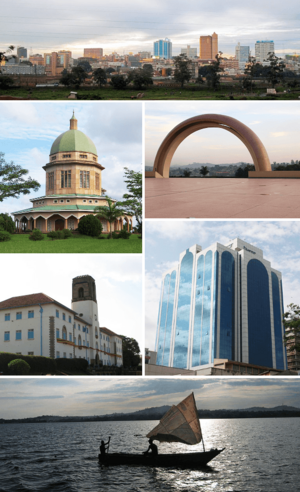
Counter-clockwise; from top: Panoramic view of central Kampala, Bahá'i Temple, Makerere University, panoramic view of Lake Victoria, Kampala Worker's House, Uganda National Mosque
|
|

Kampala highlighted in red inside the Republic of Uganda
|
|
| Country | |
| City | Kampala |
| Area | |
| • Capital city | 189 km2 (73 sq mi) |
| • Land | 176 km2 (68 sq mi) |
| • Water | 13 km2 (5 sq mi) |
| • Metro | 8,451.9 km2 (3,263.3 sq mi) |
| Elevation | 1,200 m (3,900 ft) |
| Population
(2019)
|
|
| • Capital city | 1,680,600 |
| • Density | 8,892/km2 (23,030/sq mi) |
| • Metro | 6,709,900 |
| • Metro density | 793/km2 (2,050/sq mi) |
| Demonyms | Munakampala |
| Time zone | UTC+03:00 (East Africa Time) |
| • Summer (DST) | (Not Observed) |
Kampala is the capital and largest city of Uganda. In 2024, the city proper had about 1.8 million people. It is divided into five main areas: Kampala, Kawempe, Makindye, Nakawa, and Rubaga.
Kampala's larger metropolitan area includes the city itself and nearby districts like Wakiso District, Mukono District, and Mpigi District. In 2019, this area had an estimated 6.7 million people. This makes Kampala one of the fastest-growing cities in Africa. It is also often ranked as East Africa's best city to live in.
Contents
What's in a Name?
The name Kampala comes from a hill called Old Kampala. This hill used to be a hunting ground for the King of Buganda. Many antelopes, especially impalas, lived there.
When British officials arrived, they called it "The Hill of the Impala." The local Baganda people translated this to "Akasozi ke'Empala," which means "the hill of impalas." This was shortened to K'empala, and then finally to Kampala. So, Kampala means "Hill of the Impala."
A Brief History of Kampala
The area that became Kampala was once the heart of the powerful Buganda Kingdom. The kings of Buganda often moved their capital, called Kibuga, to different hills.
Early Descriptions
The first written description of this capital was in 1860 by explorer Sir Richard Burton. He described it as a large settlement with the king's palace surrounded by fences. Later, in 1862, John Speke visited when the capital was at Bandabarogo (now Banda Hill).
In 1875, Henry Morton Stanley found the capital at Lubaga Hill. He wrote about the wide roads leading to the capital and the king's royal area.
Missionaries and British Rule
In the late 1870s, Christian missionaries arrived. Protestant missionaries settled on Namirembe Hill, and Catholic missionaries settled on Lubaga Hill. Their arrival led to some conflicts, which eventually led to the British government taking control of Buganda.
In 1890, Frederick Lugard of the Imperial British East Africa Company arrived. He signed a treaty with King Mwanga II, placing Buganda under British protection. Captain Lugard built a fort on Kampala Hill, which became known as Old Kampala.
In 1895, Mengo Senior School, the first school offering Western education, opened on Namirembe hill. In 1897, Mengo Hospital, Kampala's first Western-style hospital, also opened on Namirembe Hill.
20th Century Growth
In 1900, the Buganda Agreement (1900) was signed. This agreement formally established British colonial rule and divided land in new ways. Different hills were given to the young king, local leaders, and religious missions. For example, the Catholic mission got Lubaga Hill, and the Protestant mission got Namirembe Hill.
In 1906, the British government consolidated its land and officially named it Kampala Township. By 1912, Kampala had its first land-use plan.
In 1922, Makerere, Kampala's oldest university, was founded. It started as a technical college. In 1931, the Uganda Railway reached Kampala, connecting it to the coast. In 1938, Kampala got its first electric street lights.
After several plans to expand and develop Kampala, Uganda gained independence on October 9, 1962. Kampala became the capital city. In 1968, Kampala's boundaries expanded significantly, growing from 28 square kilometers to 189 square kilometers.
Later, in January 1986, the Battle of Kampala took place during the Ugandan Bush War. The city was captured by the National Resistance Movement.
21st Century
In 2010, the Kampala Capital City Authority Act was passed. This law gave the Ugandan Government more control over Kampala's management. It also aimed to improve the city's infrastructure.
Geography and Landscape
Kampala covers about 189 square kilometers. Most of this is land, but 13 square kilometers are water.
Hilly Terrain
Kampala is a very hilly city, with valleys often filled with swamps. The highest point is Kololo Hill, which is about 1,311 meters high. The lowest point is near Lake Victoria, at about 1,135 meters.
Kampala was originally built on seven hills, but it has grown to cover many more. The original seven hills are:
- Old Kampala Hill: Where the first British colonial headquarters were located.
- Mengo Hill: The capital of the Buganda Kingdom when the British arrived.
- Kibuli Hill: Home to the Kibuli Mosque.
- Namirembe Hill: Home to the Anglican Cathedral.
- Lubaga Hill: Home to the Catholic Cathedral.
- Nsambya Hill: Given to the British Catholic Mill Hill Mission.
- Nakasero Hill: Site of a British military base and the European Hospital.
Swamps and Rivers
Because of its hills and tropical climate, Kampala has many swamps and slow-moving rivers in its valleys. These swamps cover about 15% of the city's land. They include:
- Kinawataka swamp river
- Nakivubo swamp river
- Lubigi swamp
Climate
Kampala has a tropical rainforest climate. This means it's warm all year round and gets a lot of rain. The city has two main rainy seasons: from August to December and from February to June. April usually gets the most rain.
| Climate data for Kampala | |||||||||||||
|---|---|---|---|---|---|---|---|---|---|---|---|---|---|
| Month | Jan | Feb | Mar | Apr | May | Jun | Jul | Aug | Sep | Oct | Nov | Dec | Year |
| Record high °C (°F) | 33 (91) |
36 (97) |
33 (91) |
33 (91) |
29 (84) |
29 (84) |
29 (84) |
29 (84) |
31 (88) |
32 (90) |
32 (90) |
32 (90) |
36 (97) |
| Mean daily maximum °C (°F) | 28.6 (83.5) |
29.3 (84.7) |
28.7 (83.7) |
27.7 (81.9) |
27.3 (81.1) |
27.1 (80.8) |
26.9 (80.4) |
27.2 (81.0) |
27.9 (82.2) |
27.7 (81.9) |
27.4 (81.3) |
27.9 (82.2) |
27.8 (82.0) |
| Daily mean °C (°F) | 23.2 (73.8) |
23.7 (74.7) |
23.4 (74.1) |
22.9 (73.2) |
22.6 (72.7) |
22.4 (72.3) |
22.0 (71.6) |
22.2 (72.0) |
22.6 (72.7) |
22.6 (72.7) |
22.5 (72.5) |
22.7 (72.9) |
22.7 (72.9) |
| Mean daily minimum °C (°F) | 17.7 (63.9) |
18.0 (64.4) |
18.1 (64.6) |
18.0 (64.4) |
17.9 (64.2) |
17.6 (63.7) |
17.1 (62.8) |
17.1 (62.8) |
17.2 (63.0) |
17.4 (63.3) |
17.5 (63.5) |
17.5 (63.5) |
17.6 (63.7) |
| Record low °C (°F) | 12 (54) |
14 (57) |
13 (55) |
14 (57) |
15 (59) |
12 (54) |
12 (54) |
12 (54) |
13 (55) |
13 (55) |
14 (57) |
12 (54) |
12 (54) |
| Average rainfall mm (inches) | 68.4 (2.69) |
63.0 (2.48) |
131.5 (5.18) |
169.3 (6.67) |
117.5 (4.63) |
69.2 (2.72) |
63.1 (2.48) |
95.7 (3.77) |
108.4 (4.27) |
138.0 (5.43) |
148.7 (5.85) |
91.5 (3.60) |
1,264.3 (49.77) |
| Average rainy days (≥ 1.0 mm) | 4.8 | 5.1 | 9.5 | 12.2 | 10.9 | 6.3 | 4.7 | 6.7 | 8.6 | 9.1 | 8.4 | 7.4 | 93.7 |
| Average relative humidity (%) | 66 | 68.5 | 73 | 78.5 | 80.5 | 78.5 | 77.5 | 77.5 | 75.5 | 73.5 | 73 | 71.5 | 74.5 |
| Mean monthly sunshine hours | 155 | 170 | 155 | 120 | 124 | 180 | 186 | 155 | 150 | 155 | 150 | 124 | 1,824 |
| Source 1: World Meteorological Organization, Climate-Data.org for mean temperatures | |||||||||||||
| Source 2: BBC Weather | |||||||||||||
Education in Kampala
Kampala offers many educational opportunities, from pre-primary to university level. Both private and public schools are available.
Schools
There are many primary and secondary schools in Kampala. Most are privately owned, but some are state-owned. They are regulated by the Ministry of Education and Sports. Some well-known private schools include Kampala Parents School and Gayaza High School.
Vocational and Technical Training
Kampala also has schools that teach practical skills. These include:
- Nakawa Vocational Training Institute: Teaches skills like electricity, car repair, welding, and woodworking.
- Tiner International School of Beauty: Focuses on hairdressing and beauty therapy.
- Jimmy Sekasi Institute of Catering: Teaches about food and beverages.
Universities
The city is home to several universities, including:
- Makerere University
- Kyambogo University
- Kampala University
- International University of East Africa
People of Kampala
The population of Kampala has grown quickly. In 1948, it was about 62,000 people. By 2019, it was estimated to be over 1.6 million.
Kampala is a very diverse city. People from all over Uganda and neighboring countries like Democratic Republic of the Congo, Rwanda, and South Sudan live and work here. You'll also find people from India and China.
Even though people from different backgrounds live close together, they often identify strongly with their ethnic groups. Besides the Baganda (the main ethnic group in this region), other large groups include the Banyankole, Basoga, Bakiga, and Acholi.
Culture and Fun
Cultural Places
Kampala has important cultural places like the Uganda Museum and the Ugandan National Theatre. It is also the seat of the Buganda kingdom, with its headquarters at Mengo.
A very famous site is the Kasubi Tombs, a UNESCO World Heritage Site. This is where the kings of Buganda are buried. The Independence Monument in the city center celebrates Uganda's freedom.
Shopping and Entertainment
Kampala is great for shopping, from traditional crafts to modern fashion. Owino market is one of Uganda's largest and busiest markets. You can find clothes, shoes, and fresh food there. The city also has many shopping malls like Acacia Mall.
Kampala's nightlife is very lively, with many bars, clubs, and lounges. Areas like Kabalagala and Kololo are popular for evening entertainment.
Delicious Food
The food in Kampala is as varied as its people. Street food is very popular. You must try the famous Rolex – an omelette rolled in a chapati!
For dining out, Kampala has many restaurants. You can find traditional Ugandan dishes like Luwombo (meat or fish steamed in banana leaves) and Matoke (steamed green bananas). There are also international foods like Indian, Chinese, and Italian.
Ndere Cultural Centre
The Ndere Cultural Centre in Kisasi promotes Ugandan and African culture through music, dance, and drama. The name "Ndere" comes from the word for "flute," a symbol of how cultures connect. The Ndere troupe performs traditional music and dances from all over Uganda, Rwanda, and Burundi several nights a week.
Sports
Kampala is a big sports city. It's home to the City Oilers, a top basketball team in East Africa. The city hosted the IAAF World Cross Country Championships in 2017. It will also host parts of the 2027 Africa Cup of Nations football tournament.
Important sports venues include:
- Mandela National Stadium (Namboole Stadium): The largest stadium in Uganda, seating over 45,000 people. It's the main venue for football matches and athletics.
- Lugogo Sports Complex: Offers facilities for tennis, cricket, and boxing. The MTN Arena here is used for basketball and other indoor sports.
- Kampala Golf Club: Uganda’s oldest golf course, located in the city center.
- Hamz Nakivubo Stadium: A renewed stadium in the city center.
Kampala is also home to many football clubs in the Uganda Premier League, like Kampala Capital City Authority FC and SC Villa.
Economy
Kampala is the economic heart of Uganda. Many businesses have their headquarters here, including banks and media companies. Efforts are being made to move heavy industries outside the city center to reduce traffic.
Many people in Kampala work in the informal sector, meaning they have jobs that are not officially registered. This includes things like urban farming in the city's wetlands, where people grow food to sell in markets. In 2015, Google launched its first Wi-Fi network in Kampala.
Getting Around Kampala
Kampala is served by Entebbe International Airport, Uganda's largest airport.
- Boda-bodas: These are motorbike taxis and a very popular way to get around. They can get through traffic quickly but can be dangerous.
- Commuter Taxis: These are 15-seater minibuses used for public transport.
- Buses: In 2012, a private company started a public bus service in Kampala.
- Trains: Passenger train service between Kampala and nearby areas was restored in 2018.
- Car Rental: Car rental services have become popular, offering both self-drive and driver options.
Places of Worship
-
Uganda National Mosque (Islam)
Kampala has many places of worship for different faiths. You'll find Christian churches and temples, including Catholic, Anglican, and Baptist churches. There are also Muslim mosques.
Kampala is also home to a Bahá'í House of Worship, known as the Mother Temple of Africa. It was opened in 1961.
Notable People from Kampala
Many famous people come from Kampala, including:
- Activists: Esther Nakajjigo (humanitarian) and Pepe Julian Onziema (human rights activist).
- Artists: Alex Mukulu.
- Business Leaders: Maggie Kigozi and Sudhir Ruparelia.
- Chess Players: Phiona Mutesi, whose story was made into the movie Queen of Katwe.
- Fashion Designers: Aamito Lagum (model) and Sylvia Owori.
- Journalists: Yasmin Alibhai-Brown and Nancy Kacungira.
- Scientists: Kwatsi Alibaruho and Ash Amin.
- Sports Stars: Joshua Cheptegei (long-distance runner and world-record holder) and Jacob Kiplimo (long-distance runner).
- Writers: Marcel Theroux.
Images for kids
See also
 In Spanish: Kampala para niños
In Spanish: Kampala para niños


